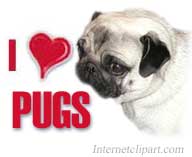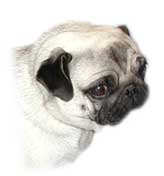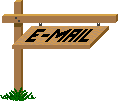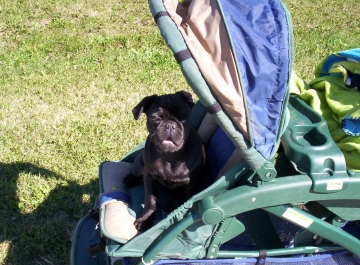
Ming Catching a Ride- 2005
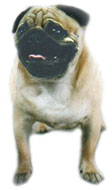
Pugs
The Origin of Pugs
Where did they come from? The origin of the Pug probably begins in China. Although they didn't look the same as the Pugs we know today. Writings from 600 BC described "short mouthed" dogs, which are probably the forerunners of the modern breed that we now call Pugs. China began trade with European countries such as Spain, Portugal, England and Holland, near the end of 1500s and early 1600s. Small dogs were presented as gifts, therefore in Europe the popularity of the Pug type dogs grew.
Pugs that had been traded to Europe, seemed to have landed mostly in Holland. Mopshond, is the name the Dutch gave to the breed, which is still used today. In 1688, Pugs were known to be in William III and Mary II household, when they ascended to the Throne of Great Britain.
William Hogarth's painting "House of Cards" depicts black Pugs therefore giving us an idea as to when they known to exist.(1730)
Pugs became more standardized as a breed, by the 1800s, with colors separating into blacks and "fawn" or "Isabella". The "black mask" was in place at this time also. There was reference to the breed as the "Dutch Mastiff", harking back the face of the "Much" larger breed The Mastiff.
In England, Pugs were first exhibited in the dog shows in 1861. When the stud book was started in 1871, 66 Pugs were in the first volume.
There were 2 main English Lines: Willoughby and The Morrison Lines.
Willoughby Pugs were thin, and leggy. Their coats were referred to as "Smutty Coat" because there was black and fawn hairs in it. Their heads were almost completely black, with "almost" saddle marks on their backs.
The Morrison Pugs, had stocky, cobby bodies. Their coats were a rich apricot-fawn color. The trace on their backs was a very light brown, rather than black. Their coats had very few black hairs at all. This line of Pugs is much like the modern day Pug.
In 1860, a huge impact to the Pug breed occurred when 2 Pugs from "pure" Chinese breeds, were brought to England. "Lamb" and "Moss" were bred and produced a son named "Click"...Click was bred many times and his blood helped mix Willoughby and Morrison Lines, making a better Pug overall. This helped shape the modern Pug as we know today.
General knowledge of the Pug...(health problems etc...)
NO BREEDER can ever produce 100% healthy-for-life dogs. Just as in humans we cannot "breed out" certain problems in our own genetic makeup, dog breeders can only do their best to work towards limiting problems in a line of dogs. Line breeding and inbreeding are two of the tools that, when used properly, can help in identifying and reducing the health problems in a breed.
Health concerns in Pugs
center primarily on two areas: their head, and their legs, although
other problems do exist. Pug heads cause problems because of the smooshed
in faces instead of having the normal elongated face of most dogs. Head
problems that are fairly common include: Cataracts
Corneal Ulcers
Dry Eye
Eyelids and Eyelashs
Elongated Soft Palatte
Pug Dog Encephalitis
Generalized Progressive Retinal Atrophy
Pinched or Undersized Nostrils
Leg problems that occur in Pugs include:
Hip Dysplasia
Legg-Calvé-Perthes disease
Slipped Stifles
Pugs also have a high incidence of demodectic skin mites (often called
demodectic mange), especially when they are still puppies. Mange does
require a veterinarian to treat it. Some lines of Pugs do not whelp
their own puppies well, often require C-section surgery at birth, and
have dams that want nothing to do with their puppies. There are also
high incidences of skin and inhalent allergies, seizure activity, and
recently we've begun to see more cases of spinal problems in Pugs as
well.
Not every Pug will have any of these problems, while others may have
more than one. And there are other health problems than can and do occur
within the breed, but not often enough to go onto this list.
Which is better for just
a pet - a male or a female Pug?
ANSWER: In general terms, males are more laid back, loving and people
oriented than females tend to be. Females, on the other hand, make better
alert dogs (they watch for strange things going on at "their"
house) and can be more aloof and independent. If you're looking for
a couch-potato type dog, then a male would normally be better suited,
although both genders get pretty laid back as older dogs. Young puppies
are rarely laid back, and often have more energy than a family expects.
If you're wanting a dog who's pretty independent and not as demanding,
then a female is probably better. These are generalities, of course.
There are some males who are independent and some females who are more
people oriented - but for the most part the characterizations hold true.
How long do Pugs normally
live?
ANSWER: Being a small breed, healthy Pugs normally live from 12 to 14
years, but can live for many more. Becoming a Pug owner becomes a long-term
commitment when you realize that you can have a Pug for as long as your
children are going to school!
Do Pugs make good watch
dogs or guard dogs?
ANSWER: Not usually. Some Pugs may alert you that someone is nearby
by barking gently (Pugs don't bark loudly, in general, because it's
muffled by the lips), but most Pugs are more interested in greeting
new people rather than scaring them off.
Because they have short
coats, are Pugs good for people with allergies, especially people allergic
to Pugs?
ANSWER: Not really. As with any breed of dog, you should try a trial
relationship with a Pug or Pug breeder. Some people only react to certain
breeds of dogs, and so anyone with allergies should check beforehand.
But Pugs are not generally known to be good for someone allergic to
dogs.
Pugs are so cute, everyone
wants one, and mine cost so much, I can really make some money if I
breed my girl Pug, can't I?
ANSWER: That's very
doubtful. The costs of raising Pugs are pretty high. Start with the
breeding: Pugs should be at least 1 1/2 - two years old before they're
bred. Your girl should be up to date on all her shots before you go
into this, as well as wormed. Then pay the stud fee, which is usually
the price of a puppy or more. If you ship your girl to be bred to a
good stud dog, add a few hundred more there too to get her to him and
back. Then there's the waiting time, and hoping she's bred. If she is,
consider that she may require a C-section. Many female Pugs have narrow
hips, and with their big heads, Pug puppies can't fit into the birth
canal. If you're lucky, you'll have an average litter of four or five
puppies. But if they were born by C-section, the dam may not be able
or willing to nurse the pups. So, you'll need bottles and formula, a
way to keep the pups warm, and round the clock feedings for the first
few days at least. Will you have to take a week off from work to raise
the puppies at first? Add that cost into the figures. There's much more
than putting two dogs together. And rarely do breeders show a profit
in doing so when they count up the hours spent and actual expenses.
That Unique Pug Appearance
Looks are what a Pug is all about. This man-made breed was created just
to look exactly like they do. The closest dog that is related to a Pug
(besides another Pug) is a Pekingese, which is to be expected with their
similar histories.
Pugs are classified as a Toy Breed, even though they are usually the largest of all the Toys. Pugs should weigh from 14 to 18 pounds, which makes them very sturdy Toy dogs. While they are described by weight, the dogs have to be in proportion to their height and bone. The body of the Pug is similar to that of a Bulldog, but not as large or as overdone. Their overall appearance should be square: the height from floor to top of withers should be equal to the length from the sternum (breastbone) to rump.
The Pug's head is the most unique and readily identifiable feature. The head itself should be round when you look at it from the front. From the side, the face should be flat without too much or too little chin. Pug eyes are round, dark, expressive and full of life. Their ears are set widely on the head, and there are two accepted types of ears: rose and button. Button ears fold over with the fold of the ear level with the top of the skull, and should not hang lower than the corner of the eye. Rose ears appear to be smaller and fold with the inner edge of the ear against the side of the head. The rose ear tends to give the head a smaller, more rounded appearance. Ears must be black all over. Wrinkles on the Pug head should be deep and easy to see because inside the wrinkle the color is darker than outside. One large, unbroken over the nose wrinkle is preferred.
The other major identifiable feature of the Pug is his tail. The tail is set up high on the back, and should be curled tightly. The double curl (two complete loops) is the ideal tail that breeders try for, but a single tight loop or twist is acceptable. It is uncharacteristic of the breed to have a floppy loose tail that bounces over the Pugs back, or a Pug who carries his tail uncurled.
Pugs come in two colors: fawn and black. Either is acceptable, although the blacks seem to be harder to come by. Many times over the years the fawns have been called, "apricot fawn," "silver fawn," "stone fawn," etc. in an attempt to differentiate them, but they are all still just fawn Pugs. Apricot fawns will have a peach or apricot tint to the coat that can have an almost clear, cream colored base coat. The other fawn coat has a mixing of black-tipped guard hairs in it, making the dog appear darker and "cooler" in color. All of these colors are acceptable - it is only the very dark coloration over the entire body of the dog that is considered "smutty" and undesirable. Either color can have a few white hairs on the chest, and both colors will turn grey in the muzzle as they age. Striping, brindling or pinto spots are NOT normal or desirable Pug colors.
Why Choose A Pug?
People seem to think that getting dog these days is just a matter of choosing one that looks cute to them. With so many different breeds of dogs being portrayed unrealistically in movies it's easy for people to think that dog ownership today is simple, a snap, a breeze, and that they'll have loving intelligent companions for the rest of their lives.
It ain't so.
Pugs are cute - if you
love them, you think they are the cutest breed around. People who consider
them ugly just don't see the beauty in the breed.
Are you looking
for a dog that will make you laugh? Then a Pug may be good for you -
they are natural clowns and show offs.
Are you looking for a dog that is good with children? Then a Pug may
be good for you as they seem to consider children to be "Pug-sized"
people.
Are you looking for a dog as a companion to your kids, to run after
them on their bikes up the street? You should pass on Pugs - their sensitivity
to heat and small size makes that almost a certain death situation.
Do you want a small watch dog for an apartment situation? MAYBE a Pug
can work - but it's not usual. Most Pugs won't know a stranger in their
entire lives, let alone recognize a burglar.
Do you want a dog that's almost human-like in personality? Then consider
a Pug, as Pugs have more personality than they know what to do with!
So a Pug may not be for everyone, but it may be for you, And I sure
know it's for ME!!

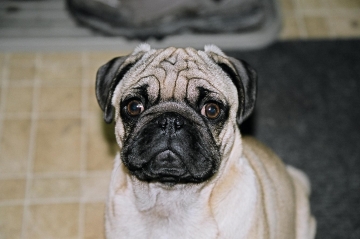
D'Mon- October 2005
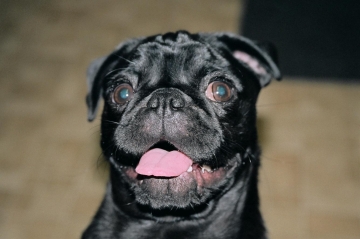
Ming- October 2005

The Pugsleys
Feel Free to Email us...
